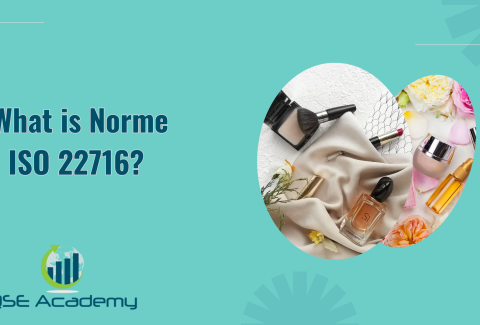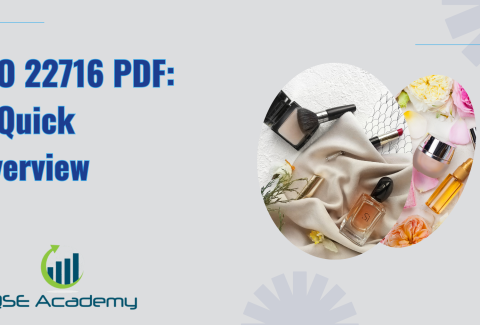ISO 22716 : Complete Guide to GMP for Cosmetic Manufacturers
What is ISO 22716?
So, you’re in the cosmetics business—whether it’s skincare, makeup, or hair care—and you’ve probably heard of ISO 22716. But what exactly is it? Simply put, ISO 22716 is the Go-To standard for Good Manufacturing Practices (GMP) in the cosmetics world. It’s like your operations’ best friend, providing a clear and structured approach to producing high-quality, safe products that your customers can trust.
From ensuring that your team knows what they’re doing, to keeping your equipment in tip-top shape and documenting everything from A to Z, ISO 22716 helps you do it all. It’s the blueprint for maintaining quality control across every aspect of production, and making sure that your products meet global safety and quality standards.
Why ISO 22716 is Important
Now, you might wonder—why should you care about ISO 22716? Well, think of it this way: ISO 22716 isn’t just a piece of paper; it’s what ensures your products are safe, consistent, and meet the expectations of your customers. If you’ve ever wanted to streamline your operations, reduce risks, or avoid costly mistakes in production, this standard is your golden ticket.
But that’s not all. ISO 22716 is also your passport to international markets. Many countries, including those in the EU and the U.S., require cosmetic manufacturers to meet GMP standards like ISO 22716. So if you’re planning to expand or export, getting certified means you’re in the clear with regulatory requirements—and, more importantly, your customers.
Who Should Use This Guide?
This guide is for everyone who has a hand in the cosmetics manufacturing process:
- Manufacturers: If you’re in charge of production, this is for you. We’ll walk you through how to implement ISO 22716 in your day-to-day operations.
- Exporters: Thinking of taking your products overseas? This guide will help you understand the GMP standards that ensure smooth international trade.
- Compliance Managers: If you’re overseeing regulatory compliance, this guide will serve as your roadmap to meeting ISO 22716’s requirements.
No matter where you’re at in your ISO 22716 journey, we’ve got the information you need to take the next step. Ready to dive in?
II. What is ISO 22716?
Definition and Purpose
So, what exactly is ISO 22716? Simply put, it’s the gold standard for Good Manufacturing Practices (GMP) in the cosmetics world. If you’re in the business of making beauty products, this is your roadmap to ensuring that what you’re producing is safe, effective, and up to par. ISO 22716 provides the blueprint for how cosmetics should be manufactured—from raw materials to the final product on the shelf.
Why does it matter so much? Well, think about all the products you put on your skin or in your hair every day. They need to meet certain safety standards to protect consumers, and ISO 22716 helps companies like yours do exactly that. It’s all about creating processes that ensure quality control and compliance, preventing contamination, and ensuring your products do exactly what they’re supposed to do—safely.
Key Objectives
So, why should you care about ISO 22716? Here’s the bottom line:
- Ensuring Product Quality and Safety At the end of the day, your customers want to know that the products they’re buying are safe and reliable. ISO 22716 helps ensure that your products are consistently made to meet the highest quality and safety standards—every single time. Whether it’s a face cream or a lipstick, your customers deserve to know that what’s in that bottle is exactly what they expect.
- Reducing Risks During Production and Distribution There’s nothing worse than a product recall or discovering a batch wasn’t made to the right standards. This standard helps you manage and minimize risks during the entire production and distribution process. It covers everything from hygiene protocols to how your equipment is maintained, making sure your manufacturing process runs smoothly without any nasty surprises.
Industries Covered
While ISO 22716 was designed with the cosmetics industry in mind, it’s relevant to a lot of other areas, too. Here’s a look at where it applies:
- Cosmetics: Think makeup, hair care products, nail polish, and all those beauty essentials.
- Personal Care: Things like deodorants, body lotions, and soaps.
- Skincare: From facial cleansers to sunscreens, serums, and moisturizers.
If your business is in any of these sectors, or you’re thinking about stepping into the beauty industry, ISO 22716 will guide you in building processes that ensure your products are both compliant and of top-notch quality.
III. Benefits of Implementing ISO 22716
For Manufacturers
So, what’s in it for you, the manufacturer? Let’s talk about some of the big wins here:
- Improved Product Quality and Safety
When you implement ISO 22716, you’re setting up a system that makes sure your products are not only consistent but also safe for use. It’s like putting a protective shield around your products, ensuring that everything from the ingredients to the final product is top-tier quality. No more guessing—just solid, repeatable processes that guarantee your products are safe for customers. - Streamlined Operations and Reduced Risks
Let’s face it: nobody likes dealing with operational headaches or the fear of a product recall. ISO 22716 helps streamline your entire production process, making it smoother, faster, and more efficient. By managing risks early on—whether it’s contamination, poor documentation, or faulty equipment—you’ll keep things running smoothly and avoid disruptions that can cost you time, money, and reputation.
For Consumers
It’s not just about what’s happening behind the scenes; consumers get some pretty big benefits too. Here’s how:
- Ensures Product Safety and Transparency
Today’s consumers are savvy—they want to know where their products come from and how they’re made. With ISO 22716, you’re giving them the peace of mind that their products are made with care, safety, and compliance at the forefront. Whether it’s that new skincare product or a fresh batch of mascara, they’ll know that what’s inside the packaging has been made to the highest standards. Transparency builds trust, and trust leads to loyalty.
For Exporters
And if you’re an exporter, this one’s especially for you:
- Facilitates Compliance with International Regulations
International trade means you’re playing by the rules of the big leagues. ISO 22716 is recognized globally, and by implementing it, you’re positioning your products for easy market access—whether it’s the EU, the U.S. FDA, or other international regulatory bodies. This certification makes it easier to meet those complex regulatory requirements, clearing the way for smoother export processes. Not only will it help you avoid penalties, but it’ll also give you a competitive edge in global markets.IV. Core Requirements of ISO 22716
ISO 22716 lays out the key areas every cosmetic manufacturer must focus on to maintain GMP (Good Manufacturing Practices). Let’s dive into the essential sections and see what they really mean for your operations.
Key Sections of the Standard
1. Personnel: Training, Hygiene, and Qualifications
It all starts with the people. The heart of your operations is your team, and ISO 22716 places heavy emphasis on having the right training and qualifications. Here’s why:
- Training: You need to ensure that everyone from your production staff to your management team is well-trained in GMP practices. This doesn’t mean just a one-time training session—it’s about ongoing development and regular refresher courses. For example, if you’re manufacturing a skincare product, your production team should be trained on potential risks such as contamination, the importance of batch tracking, and correct storage procedures.
- Hygiene: GMP in cosmetics demands stringent hygiene practices. This includes everything from handwashing protocols to ensuring that production areas are kept spotless. Imagine a situation where an employee forgets to wash their hands after handling raw materials, and it contaminates a batch of products. Not only does this affect the product’s quality, but it could also lead to recalls or regulatory penalties.
- Qualifications: Your personnel must meet specific qualifications for their roles. For example, anyone involved in quality control (QC) should have relevant qualifications or experience in chemistry, microbiology, or a related field to ensure that they can assess and guarantee product quality effectively.
2. Premises: Cleanliness, Layout, and Maintenance
The facilities where products are made are just as crucial as the people making them. Your premises need to be designed and maintained to meet ISO 22716 standards.
- Cleanliness: This isn’t just about wiping down surfaces every now and then. Regular cleaning protocols must be in place to ensure the production areas are free from contaminants. For example, a manufacturer of facial creams must ensure that their mixing equipment is sanitized after each batch to prevent cross-contamination between products.
- Layout: The layout of your facility should be designed to minimize contamination and cross-contamination risks. Different areas for raw materials, production, and finished goods should be clearly separated. This could mean having dedicated storage for sensitive ingredients and ensuring that your packaging area is kept separate from where raw materials are handled.
- Maintenance: Equipment and facilities need regular checks to avoid malfunctions that could affect product quality. Scheduled maintenance is essential for preventing issues like equipment breakdowns, which could delay production and compromise the quality of your products.
3. Equipment: Maintenance and Calibration
Maintaining your equipment isn’t just a “nice to have” – it’s a critical requirement for ISO 22716 compliance.
- Maintenance: Equipment must be regularly cleaned, serviced, and repaired. For instance, if you’re using automated machinery to fill bottles with shampoo, it’s essential that it’s regularly inspected to ensure there’s no wear-and-tear that could cause inconsistencies in the amount of product dispensed.
- Calibration: Regular calibration ensures that measuring instruments are accurate. Let’s say you’re producing a specific batch size of moisturizer. If your scales aren’t properly calibrated, you might end up with too much or too little of a key ingredient, affecting the product’s consistency and effectiveness.
4. Raw Materials: Quality Control and Storage
Your raw materials are the foundation of your product, so handling them properly is crucial for maintaining quality.
- Quality Control: Before materials like oils, fragrances, or preservatives even make it into production, they should be carefully checked for quality. For example, a batch of essential oils used in a skincare line should be tested for purity and consistency to avoid any harmful effects on the final product.
- Storage: Proper storage ensures raw materials don’t degrade or get contaminated before they’re used. For instance, temperature-sensitive ingredients like certain vitamins or extracts should be stored in climate-controlled conditions to maintain their efficacy and prevent spoilage.
5. Documentation: Records and Traceability
This is where it gets really important. Documentation is not just for show—it’s about maintaining a clear, traceable record of everything that happens in your production process.
- Records: You must keep detailed records of everything—from raw materials received to the final batch produced. Let’s say there’s a product recall; you’ll need a robust system in place to trace every batch, identify what went wrong, and pinpoint where it happened. Without proper documentation, this would be nearly impossible.
- Traceability: If you can’t track every step, you can’t guarantee quality. You should be able to trace back to each ingredient used in a product and every action taken during production. This is essential not only for product safety but also for regulatory compliance. For example, if an ingredient in your lip balm turns out to be contaminated, you should be able to trace exactly which batches were affected.
6. Internal Audits: Monitoring and Evaluation
Continuous monitoring and evaluation are key to ensuring that your QMS stays effective.
- Internal Audits: Regular internal audits help you check if your processes are being followed correctly and if they’re still aligned with ISO 22716. These audits should cover all aspects—from personnel to equipment and documentation. For instance, if an audit reveals that hygiene protocols aren’t being followed properly, you’ll know exactly where the problem lies and can take immediate corrective action.
- Evaluation: Periodic evaluations ensure that your system is evolving and adapting to new risks, technologies, or market changes. For example, as your business grows or new regulations are introduced, you’ll need to assess whether your current systems still meet the necessary requirements.
7. Management Requirements in ISO 22716
When it comes to cosmetic products, managing quality throughout the entire production process is crucial. ISO 22716 doesn’t just ask cosmetic manufacturers to comply with rules—it asks management to lead by example, setting the tone for quality and safety at every stage. From raw materials to finished products, the whole team, from top to bottom, has to stay focused on product quality and safety compliance.
One of the first things management needs to do is set clear policies around quality assurance. This includes defining the quality criteria for raw materials, processes, and packaging, ensuring that cosmetics manufacturers are meeting regulatory requirements at every turn. Think of it as creating a roadmap to ensure your team always knows where to go and how to get there—whether you’re dealing with manufacturing risks or addressing safety aspects in finished products.
Another critical aspect? Documentation. ISO 22716 requires that everything is documented, from packaging operations to the conditions in which raw materials are stored. And it’s not just about having paperwork lying around—it’s about creating traceability. That means your team must be able to show where the product came from, what happened during manufacturing, and where it went. This isn’t just a nice-to-have; it’s essential for proving your business meets international standards and safety compliance.
Of course, none of this works without regular internal audits. Management must ensure that audits are conducted to monitor performance, identify weaknesses, and implement corrective actions. Whether it’s an issue with product safety or the packaging units, these audits help to identify problems before they become costly mistakes.
And let’s not forget the importance of employee training. ISO 22716 places a strong focus on making sure all employees—whether they’re handling production processes or working in the quality control laboratory—are properly trained in GMP practices. By providing adequate training, management ensures that everyone understands the significance of product safety and their role in keeping the business compliant with quality standards.
The beauty of ISO 22716 is that it doesn’t just focus on fixing problems—it’s about continuous improvement. By consistently evaluating and refining your processes, management ensures that the company is always moving forward. From risk assessments to training programs and internal audits, it’s all about building a company culture that prioritizes quality management and regulatory compliance at every step.
8. Compliance Essentials
So, how does a company meet ISO 22716 requirements? Here’s a quick checklist of essential steps:
- Ensure Personnel are Properly Trained and Qualified – Make sure that all employees understand GMP practices and are regularly updated with the latest standards.
- Maintain High Standards for Premises and Equipment – Regular cleaning, maintenance, and calibration of equipment are vital to prevent quality issues.
- Implement Strict Raw Material Control – Inspect and store raw materials according to ISO 22716 guidelines to ensure they’re up to standard.
- Keep Detailed Documentation – Track every step in the production process and ensure records are easily accessible and traceable.
- Conduct Regular Internal Audits – Set up a process for monitoring, reporting, and correcting any deviations from the established GMP.
By adhering to these principles, you can ensure your company not only complies with ISO 22716 but excels in delivering high-quality, safe cosmetic products to your customers.
V. How to Get ISO 22716 Certified
ISO 22716 certification is like a badge of honor for cosmetic manufacturers. It shows that you’ve gone above and beyond to meet Good Manufacturing Practices (GMP) and provide customers with the safest, highest-quality products possible. But how do you actually get there? Let’s break it down—step by step. Trust me, it’s not as daunting as it sounds!
Step-by-Step Process
1. Conduct a Gap Analysis
Alright, before you dive in head-first, let’s take a step back. The gap analysis is like the map you need to navigate your way through the certification process.
- Assess your current practices: Do your manufacturing processes already follow GMP standards, or are there some areas that need improvement?
- Spot the gaps: Let’s say your documentation process isn’t up to par or your hygiene practices could be better. This is the time to spot and address those gaps.
- Create an action plan: Once you know what needs fixing, draw up a plan with clear tasks. Prioritize the issues that need the most attention—like upgrading your equipment or improving your internal audits.
2. Train Employees on GMP Principles
Getting ISO 22716 certified isn’t just about systems and paperwork—it’s also about your team’s buy-in. Everyone has to understand and embrace GMP principles.
- Interactive training: Hold workshops, webinars, or even fun quizzes to teach your team about GMP. Make it engaging and practical so they know how to implement these practices in their day-to-day jobs.
- Keep it continuous: GMP is not a one-time thing—it’s about creating a culture. So, include regular refresher training sessions. For example, having a monthly “GMP check-in” can keep everyone on their toes.
3. Prepare Required ISO 22716 Documentation
This is where you’ll spend some time getting your paperwork in order—but it’s so worth it! ISO 22716 demands clear, organized documentation that proves you’re following the right processes.
- Write clear procedures: Whether it’s raw material control, production steps, or employee hygiene practices, every procedure must be documented.
- Track everything: From employee training records to audit results, keep a record of everything. You can use software tools to make it easier—like a document management system to store all your policies and procedures in one place.
4. Implement ISO 22716 Practices
Okay, now comes the fun part—putting all of your hard work into action! This is where you apply everything you’ve documented into your daily practices.
- GMP in action: It’s time to walk the talk. Make sure your team follows the procedures you’ve outlined. For instance, ensure that all production workers are consistently following proper hygiene protocols.
- Monitor effectiveness: Have systems in place to track how well everyone is following the new processes. You can even use checklists or mobile apps to make it easier to document and monitor daily activities.
5. Conduct Internal Audits
Before you invite the auditors in, you’ll need to do some self-checks to make sure everything is up to snuff. Conduct internal audits to see if your team is following GMP properly.
- Audit everything: Check every process, from equipment maintenance to employee hygiene. Look for any inconsistencies or areas where improvements could be made.
- Correct mistakes early: Catching errors or deviations before the official audit gives you the chance to fix them. If your paperwork’s incomplete or some steps are skipped, now’s the time to get them straightened out.
6. Hire a Certification Body
Now you’re ready for the big league: it’s time to hire a certification body. These are the experts who will come in, review your processes, and determine if you meet ISO 22716 standards.
- Find the right fit: Make sure the certification body you choose is accredited and recognized in your industry. They’ll guide you through the certification audit, making sure everything’s in order.
- Certification audit: The auditor will go through your procedures, policies, and documentation, reviewing whether everything aligns with ISO 22716. They’ll check your facilities, your equipment, and your records. Don’t worry—if everything’s ready, you’ll pass with flying colors!
7. Pass the Certification Audit
Once your audit is complete, it’s time to celebrate! If you’ve followed all the steps and your practices align with ISO 22716, you’ll be certified.
- What happens next? Take a moment to bask in the glory of your hard work! But remember, this is just the beginning. Keep up the good work and always strive to improve your practices.
- Maintain ISO 22716 standards: Regular audits, employee training, and process improvements are all part of maintaining your certification. ISO standards aren’t one-time achievements—they require continuous effort.
Timeline
The timeline to get certified can vary depending on the size of your company and the complexity of your processes, but here’s a rough guide:
- Small to medium-sized businesses: Expect to spend 3-6 months getting everything ready. It takes time to train your team, document your processes, and make adjustments to meet ISO standards.
- Larger companies: If you have a bigger operation with multiple locations or complex processes, you might need around 6-12 months to prepare.
Costs
Cost is always a big consideration when pursuing certification, but remember—ISO 22716 is an investment that will pay off by boosting product quality, ensuring customer safety, and opening doors for international trade.
- Company size and complexity: A smaller company will generally spend less than a larger, multi-location business. The bigger your company, the more complex your processes, which means more time and resources spent on compliance.
- Preparation costs: You might need to hire consultants, buy software tools, or conduct additional employee training, all of which can add to the cost.
- Certification body fees: Certification audit fees range from $2,000 to $10,000 depending on the scope and the certifying body. But keep in mind: this investment can be recouped quickly once you’re certified and ready to compete on the global stage.
Getting ISO 22716 certified is no small feat, but it’s a powerful way to show your commitment to quality and customer safety. Follow these steps, stay focused, and soon you’ll be holding that certificate proudly in your hands—ready to bring top-notch cosmetic products to consumers worldwide!
VI. Common Challenges in ISO 22716 Compliance
Let’s be honest—getting ISO 22716 compliance can be a bit like learning to ride a bike. You might fall off a few times, but once you get the hang of it, everything clicks into place. It’s natural to face some challenges along the way. But the good news? There are solutions for almost everything. Let’s break down some of the most common issues businesses run into and how you can power through them.
Key Issues
1. Lack of Employee Training
One of the biggest roadblocks I see (and I’ve seen it a lot) is employees not fully understanding the importance of GMP or ISO 22716. If your team isn’t trained properly, it’s easy to fall into old habits, miss crucial details, or overlook key standards. It’s like trying to run a race with no clear instructions. Without proper training, it’s hard for everyone to stay on the same page and maintain the high standards required by ISO 22716.
2. Poor Documentation Practices
ISO 22716 is all about consistency, and guess what? If your documentation is messy, incomplete, or inconsistent, you’re setting yourself up for problems down the line. Poor documentation practices can make it impossible to show that you’re following the proper procedures—especially when it comes to audits. I’ve seen companies get tripped up by this, struggling to prove compliance when their records aren’t clear or up-to-date. You need bulletproof documentation that’s organized, easy to follow, and accurate.
3. Inadequate Internal Audits
Imagine setting out to build a house without checking the foundation. That’s what happens if you’re not conducting regular internal audits. Without this crucial step, you miss out on spotting weaknesses in your processes, which means potential risks are left unchecked. Internal audits are your company’s “safety net,” making sure everything is functioning as it should. If you neglect them, you might find out the hard way when the certification auditors come knocking.
How to Overcome Them
Now, the fun part—solving these challenges. Here are some practical steps that you can take to make sure your ISO 22716 journey is smooth and successful.
1. Employee Training
Solution: Invest in comprehensive training programs that are engaging, interactive, and aligned with ISO 22716 standards. Don’t just throw a bunch of slides at your employees—give them real-world scenarios, videos, and even hands-on sessions if you can. The more they can connect with the material, the more likely they are to take it seriously. And don’t stop at a one-time training session! Regular refreshers keep the information top of mind and ensure that your team stays up to date on best practices.
- Example: Set up quarterly workshops or e-learning courses that cover the core aspects of GMP. Make sure these sessions are accessible to all levels of your staff, from top management to the shop floor.
2. Streamlining Documentation
Solution: Use templates, checklists, and software to standardize your documentation process. Keep it simple and organized—don’t overcomplicate things. A common issue I’ve seen is companies trying to create custom systems that are too complex. Stick to what works: clear and concise records that everyone can follow. Using project management software (like Asana or Notion) for documentation tracking can streamline this significantly.
- Example: Set up an online database where all your process documents are stored, easily accessible, and regularly updated. This not only helps with internal consistency but makes audits a breeze!
3. Conducting Effective Internal Audits
Solution: Make internal audits a regular part of your routine, not just something you do when a big audit is coming up. Set a schedule for audits and stick to it. Conducting regular audits will not only help you stay compliant but also allow you to catch issues before they become bigger problems. One of the best practices I recommend is having different employees or departments conduct internal audits to get multiple perspectives.
- Example: Schedule monthly internal audits with your quality control team, where you go over key processes, check for compliance, and make notes of areas for improvement. It’s like a mini check-up for your business, ensuring everything stays on track.
Navigating ISO 22716 compliance might feel like a mountain to climb, but by addressing these challenges head-on, you’ll not only meet the standard—you’ll exceed it. The key to success is consistency, transparency, and a proactive mindset. Every step you take now will ensure that your business is on the path to quality, compliance, and success. And hey, there’s always room for improvement—keep learning, keep evolving, and you’ll see the rewards.
VII. ISO 22716 and Regulatory Compliance
When it comes to compliance, there’s no one-size-fits-all. Different regions have different rules, but the good news is, ISO 22716 is designed to fit seamlessly with local regulations, making your life a whole lot easier. Whether you’re based in the EU, the US, or somewhere else in the world, this standard has you covered. Let’s break down how ISO 22716 aligns with some of the major regulations, and why that’s a game-changer for your business.
ISO 22716 vs. Local Regulations
1. Alignment with EU Regulations (e.g., EC 1223/2009)
If you’re dealing with the cosmetics industry in Europe, you’ve probably come across the EC 1223/2009 regulation. This is the EU’s set of rules for cosmetic product safety, and it’s strict. Now, here’s where ISO 22716 comes in—it’s essentially a best practice guideline that aligns with the EU’s cosmetic product requirements. By following ISO 22716, you’re already ticking off many of the boxes for EC 1223/2009, especially when it comes to product safety, manufacturing practices, and quality control.
- Why this matters: If you comply with ISO 22716, you’re also demonstrating compliance with EU cosmetic safety regulations. This makes the whole process smoother when you’re exporting your products to Europe. You’re not only proving that your products are safe but that they’ve been manufactured under high-quality standards.
- Real-World Example: Let’s say you manufacture a skincare cream. If you follow ISO 22716, you’re already meeting most of the EU requirements for safe production of cosmetics. This can streamline approval processes when selling in European markets and can be a selling point to your customers.
2. Alignment with FDA Cosmetic GMP Requirements
On the other side of the pond, if you’re targeting the US market, the FDA’s cosmetic GMP standards are your point of reference. The FDA has strict regulations for cosmetics, but ISO 22716 can help you navigate these rules. While ISO 22716 is more focused on general manufacturing practices, it shares many of the same core principles with the FDA’s requirements, such as cleanliness, safety, documentation, and record-keeping.
- Why this matters: Complying with ISO 22716 ensures that your processes align with the FDA’s cosmetic GMP standards. This means you’re already on the right track if you want to sell in the US. And trust me, this alignment can speed up your product’s path to market while also ensuring that your products meet international safety standards.
- Real-World Example: Let’s say you’re producing a hair care product for the US market. By meeting ISO 22716 standards, you’re ensuring your manufacturing process is aligned with FDA expectations—this makes it easier to pass FDA audits, saving you time and potential headaches down the road.
Global Impact
ISO 22716 isn’t just about following one region’s rules. Its real strength lies in its global compatibility. If you’re thinking about international trade and want your products to be accepted in multiple markets, ISO 22716 is the way to go. This standard helps businesses cross borders and expand their reach, and here’s why:
1. Importance for International Trade and Market Access
Cosmetic manufacturers often face barriers when trying to enter foreign markets. But by adopting ISO 22716, you’re already making your products more marketable globally. Many countries, particularly in Europe, Asia, and North America, are increasingly recognizing ISO 22716 as a credible proof of quality and safety. This opens up doors for international partnerships, export opportunities, and regulatory approvals.
- Why this matters: Think about all the paperwork, inspections, and certifications required when selling internationally. With ISO 22716, you streamline that process. The global recognition of this standard means that you’re seen as a compliant, trustworthy business right from the start.
- Real-World Example: Say you want to sell your cosmetic products in Japan. Japan is known for having high standards for cosmetics. If your products are ISO 22716 certified, it’s a clear signal that you meet rigorous international standards, making your product more attractive to Japanese regulators and consumers alike.
Whether you’re targeting the EU, US, or looking to go global, ISO 22716 doesn’t just help you meet regulations—it makes your business internationally competitive. The best part? By aligning with both local and international regulations, you ensure that your products are safe, effective, and trusted by consumers and authorities across the world. It’s not just about staying compliant—it’s about setting your business up for success on a global scale.
IX. Conclusion
We’ve walked through a lot in this guide, so let’s hit the key points. ISO 22716 is a powerful tool for any cosmetic manufacturer looking to ensure product quality, safety, and regulatory compliance. Whether you’re a manufacturer, exporter, or compliance manager, this standard isn’t just a checkbox—it’s a framework that improves your operational efficiency, helps you reduce risks, and builds consumer trust.
By implementing ISO 22716, you’re setting up your business for long-term success. You’re ensuring that your products are made in a safe environment, your processes are transparent, and your documentation is rock solid. For exporters, ISO 22716 is your golden ticket to international markets, helping you meet global standards and make sure your products are welcomed in regions like the EU, US, and beyond.
Emphasizing Benefits for Manufacturers, Consumers, and Exporters
For manufacturers, ISO 22716 ensures that you’re creating top-quality products, which can help boost your reputation and open doors to new opportunities. It streamlines your operations, cuts down on waste, and minimizes risks, leading to better efficiency and lower costs.
Consumers are the real winners, as they can trust that the products they’re buying are safe, effective, and made under rigorous standards. This transparency not only drives customer satisfaction but also loyalty.
For exporters, ISO 22716 offers a seamless path to compliance with international regulations, ensuring that your products meet the strict requirements of foreign markets like the EU and the US.
Ready to take your cosmetic manufacturing process to the next level? We’ve got plenty of resources to help you along the way.
- Dive into our related articles like the “GMP Audit Checklist” to make sure you’re covering all your bases.
- Download our guides and templates to help you implement ISO 22716 in your operations.
- Need expert help with ISO 22716? Reach out to our consulting services for tailored advice and support to make the certification process smoother for you.
Let’s face it—getting ISO 22716 certified is more than just a regulatory requirement; it’s a game-changer for your business, and we’re here to help you every step of the way.

make ISO standards less intimidating and more approachable for everyone.
Whether it’s ISO 9001, ISO 22000, or the cosmetics-focused ISO 22716,
I’ve spent my career turning complex jargon into clear, actionable steps
that businesses can actually use. I’m not here to call myself an expert—I prefer “enthusiast” because I truly love what I do.
There’s something incredibly rewarding about helping people navigate food safety and quality management systems
in a way that feels simple, practical, and even enjoyable.
When I’m not writing about standards, you’ll probably find me playing Piano 🎹, connecting with people, or diving into my next big project💫.
- I’m an engineer specialized in the food and agricultural industry
- I have a Master’s in QHSE management and over 12 years of experience as a Quality Manager
- I’ve helped more than 15 companies implement ISO 9001, ISO 22000, ISO 22716, GMP, and other standards
- My clients include food producers, cosmetics manufacturers, laboratories, and service companies
- I believe quality systems should be simple, useful, and efficient
- Outside of work, I play piano and love learning something new every day
Let’s make ISO less about stress and more about success! 🙏
Looking for More Resources on ISO 22716?
If you found this article helpful, explore our premium resources designed to help you achieve ISO 22716 certification efficiently:
- 📦 Complete Documentation Package for ISO/IEC 22716 2017: Get all the essential templates and documents you need for fast, easy implementation.
- 🎓 Online Course on ISO/IEC 22716 2017 : Enroll in our comprehensive training to master the key concepts and practical steps toward certification.
- 📋 ISO/IEC 22716 2017 Checklist: Download our detailed checklist to ensure you’ve covered every step of the process.
These resources are tailored to meet your needs and ensure a smooth certification journey. Explore them today and get one step closer to success!






















